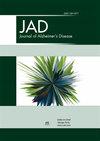阿尔茨海默病是一种突触竞争性可塑性失调疾病的证据
IF 3.4
3区 医学
Q2 NEUROSCIENCES
引用次数: 0
摘要
越来越多的证据表明,淀粉样蛋白-β(Aβ)的生理功能是介导大脑中依赖神经活动的平衡和竞争性突触可塑性。我曾总结过支持这一假说的证据,并强调了 Aβ 与抗微生物肽在介导细胞/突触竞争方面的相似之处。在细胞竞争中,抗微生物肽采用多种机制确保自我保护和消灭竞争者。在此,我回顾了最近的研究,这些研究表明,类似的机制也在 Aβ 介导的突触竞争中发挥作用,而这些机制的紊乱是阿尔茨海默病(AD)的基础。具体而言,我将讨论 Aβ 和载脂蛋白E(ApoE)这两种在阿兹海默病(AD)中起关键作用的物质共同调节突触竞争的证据。神经胶质载脂蛋白E通过增加营养性单体Aβ的产生和抑制其组装成毒性寡聚体来促进自我保护。相反,Aβ 寡聚体一旦聚集,就会通过直接的毒性活动和 "吃我 "信号的放大促进弱突触的消除,从而促进竞争突触的消除。我进一步总结了神经元载脂蛋白E可能是通常促进竞争可塑性的基因调控网络的一部分的证据,从而解释了AD大脑中表达载脂蛋白E的神经元的选择性脆弱性。最后,我讨论了睡眠可能是Aβ协调可塑性的关键的证据,其中睡眠不仅是Aβ诱导的,也是Aβ介导的可塑性所必需的,强调了睡眠与AD之间的联系。总之,这些结果有力地证明,注意力缺失症是一种竞争性突触可塑性出错的疾病,这种新观点可能会促进注意力缺失症的研究。本文章由计算机程序翻译,如有差异,请以英文原文为准。
Evidence that Alzheimer’s Disease Is a Disease of Competitive Synaptic Plasticity Gone Awry
Mounting evidence indicates that a physiological function of amyloid-β (Aβ) is to mediate neural activity-dependent homeostatic and competitive synaptic plasticity in the brain. I have previously summarized the lines of evidence supporting this hypothesis and highlighted the similarities between Aβ and anti-microbial peptides in mediating cell/synapse competition. In cell competition, anti-microbial peptides deploy a multitude of mechanisms to ensure both self-protection and competitor elimination. Here I review recent studies showing that similar mechanisms are at play in Aβ-mediated synapse competition and perturbations in these mechanisms underpin Alzheimer’s disease (AD). Specifically, I discuss evidence that Aβ and ApoE, two crucial players in AD, co-operate in the regulation of synapse competition. Glial ApoE promotes self-protection by increasing the production of trophic monomeric Aβ and inhibiting its assembly into toxic oligomers. Conversely, Aβ oligomers, once assembled, promote the elimination of competitor synapses via direct toxic activity and amplification of “eat-me” signals promoting the elimination of weak synapses. I further summarize evidence that neuronal ApoE may be part of a gene regulatory network that normally promotes competitive plasticity, explaining the selective vulnerability of ApoE expressing neurons in AD brains. Lastly, I discuss evidence that sleep may be key to Aβ-orchestrated plasticity, in which sleep is not only induced by Aβ but is also required for Aβ-mediated plasticity, underlining the link between sleep and AD. Together, these results strongly argue that AD is a disease of competitive synaptic plasticity gone awry, a novel perspective that may promote AD research.
求助全文
通过发布文献求助,成功后即可免费获取论文全文。
去求助
来源期刊

Journal of Alzheimer's Disease
医学-神经科学
CiteScore
6.40
自引率
7.50%
发文量
1327
审稿时长
2 months
期刊介绍:
The Journal of Alzheimer''s Disease (JAD) is an international multidisciplinary journal to facilitate progress in understanding the etiology, pathogenesis, epidemiology, genetics, behavior, treatment and psychology of Alzheimer''s disease. The journal publishes research reports, reviews, short communications, hypotheses, ethics reviews, book reviews, and letters-to-the-editor. The journal is dedicated to providing an open forum for original research that will expedite our fundamental understanding of Alzheimer''s disease.
 求助内容:
求助内容: 应助结果提醒方式:
应助结果提醒方式:


